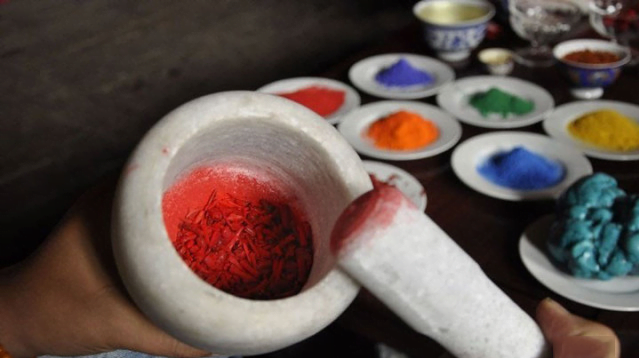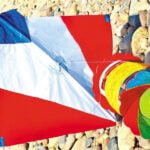Tibetan thangka art, a beautiful flower in the treasure house of traditional painting of the World, is rich, colourful, mysterious, and charming. Its pigmentation and colour usage are unique. Even after centuries, an exquisite thangka remains dazzling and brilliant.
The artistic value of thangka lies in its drawing process. Thangkas are rich in colours, utilizing up to 160 different colour combinations. These colours originate from five basic colours – white, red, green, blue, and yellow, which are then mixed in varying proportions. The painter’s colour matching is intricate, showcasing their skill in manipulating pigments. This unique colour production, deployment, and utilization technique contributes to the vibrant and enduring reputation of Thangka art.
Sources of colors in Tibetan Thangka Painting
The selection of thangka colours and painting materials is closely tied to the complex and rigorous production process. As a religious nation, Tibetans hold thangkas in high regard and are meticulous in selecting painting materials, using only natural pigments. The resulting artworks possess pure and vibrant colours, high quality, and exceptional lightfastness, ensuring they will not fade over time.
Thangka pigments primarily consist of minerals and plants. Mineral colours include white clay, red clay, southern alkali, cinnabar, indigo stone, borax, cold water stone, copper ore, gold, silver, tortoiseshell stone, opal, rouge, and ink ingots. Plant materials include wild chrysanthemum, meconopsis, yellow flower, delphinium, sunshade, green lotus, rosin, saffron, gentian, turmeric, and seaweed parasites.
Pigments made from pure gold and silver or ground from different types of jewellery are used to enhance the colour of the picture, making it more vibrant and long-lasting. Gold is an essential element in thangka, where it is ground and used to draw intricate lines and patterns. Gold can also be mixed with coral or agate to create various hues. The artist uses multiple layers of paint on the gold-painted painting to achieve the desired effect.

Traditional Color Pigment preparation method
The traditional thangka pigment preparation methods have been handed down through generations. The overall process involves collection, selection, cleaning, soaking, boiling, grinding, evaporation, and pill-making. Prior to the 1990s, all these steps were carried out manually. With technological advancements, certain equipment has been enhanced and some processes are now performed by semi-automatic machines. Nevertheless, experienced technicians still manually carry out tasks like fine grinding, grinding, layering, and separation.
Various pigments for Thangka paintings are prepared individually. Blue pigment is derived from a grass known as “Oran”. Carmine pigment is obtained from the yellow bark found in the Zayu region, which is boiled in water. Azurite and azurite, two colours that belong to the same mineral, are separated during processing. To separate them, the mineral is first crushed into granules and then ground into a fine powder. It is then fried in a casserole with vegetable oil, causing the azurite to float on top and the azurite to sink to the bottom.
After wet-grinding the azurite in a container for several days, the uppermost layer becomes light blue, the second layer becomes blue, the third layer becomes sky blue, and the bottom layer becomes cyan.
After conducting research, the stone has three layers of green: light, standard, and dark. These layers can be easily distinguished by experienced technicians. The mineral pigments used are pure and do not fade. The process of extracting colour from plants involves placing small porcelain bowls on a charcoal fire and gradually pouring the boiled liquid into the bowls to allow evaporation.
Plant colour pills require soaking and precipitation to remove impurities and maintain colour purity. To produce cold golden yellow, gold is ground into paper-thin flakes, which are then cut into thin wires. The gold wires are mixed with ground stone and glass powder and ground with round stones. Water is added gradually until the mixture becomes a thick, gooey consistency. Finally, the mixture is washed with clean water to remove the stone and glass powder, leaving behind a solution containing gold powder.
Mixing the different sources of colour
When mixing paint, attention should be given to overlooked details such as fire level, glue concentration, and force size. Insufficient mastery can result in colour changes. For instance, to obtain cinnabar pigment, gently grind the ore into powder in a bowl. Excessive force will make the pigment colour cloudy. The glue concentration should be controlled to avoid being too thick or too thin. Thick glue can cause the base colour to crack or warp, while thin glue may lead to an unstable base colour that could eventually fall off. Thus, adjusting the glue thickness based on experience is necessary.
In addition to various treasures, a large number of mineral pigments are the main components of painting Thangka. In modern times, some people use advertising pigments instead of mineral pigments, shoddy, and lose the most precious characteristics of Thangka traditional pigments. The advertising colours of these chemical ingredients are bright at the beginning, but they are easy to deteriorate and change colour, and it is not easy to preserve.
Basic Skills of Thangka Painting and Color Preparation
Colour processing and application a fundamental skills in Thangka painting. Each content requires specific methods and steps, with colour intensity being crucial. Creating an exquisite Thangka typically requires months or even years. Traditional dyeing techniques, such as “separate dyeing from outer to inner, dark roots with light edges,” and the gradual lightening method, are widely employed. Uniform highlighting strokes and consistent spot-dyeing handwriting are essential, while flat dyeing should be done without leaving pen marks.
When painting a Thangka, it is crucial to follow strict procedures in order to achieve an elegant and intricate result. Mastering the balance between lightness and heaviness is essential, as these techniques are unique to this form of painting. A variety of colours are required for drawing a Thangka, including not only the main colour but also various mixed colours. The technique of dipping the pen is also important as it affects the colour effect of the picture.
Different colours require different approaches when dipping the brush into the paint bowl. For instance, colours like white, stone yellow, and realgar should be taken from the top of the snow-capped mountains, while bright red, orange-red, sub-pink, gold powder, silver powder, and metallic colours need to be dipped from the bowl wall. Turquoise products, on the other hand, must be taken from the seabed.
Bone glue and a small amount of oxgall are added to the paint to prevent corrosion. The colours are applied one at a time, starting with the light colour followed by the dark colour. Each layer of colour is applied thinly to achieve a delicate and heavy texture. If the canvas absorbs the paint well, it will have a natural and transparent appearance. Cyan is commonly used to depict the sky. When painting, begin by applying three flat layers of cyan for the sky, then add two wet layers of cyan before applying spot dye.
Unique colour symbols for Each Buddha and Boddhisttva
The Buddhas and Bodhisattvas in Thangkas have unique colour symbols. When painting a Buddha statue, start with the lotus seat, then the canvas decoration, and finally the Buddha body. Begin by painting the empty eyes, then use gold or colour to paint the patterns on the clothes, and finish by painting the eyes. Drawing gold thread requires superb skill, using a small brush and a little gold leaf powder. The artist’s drawing encompasses all the subtleties, which is a great test of their skills and adds a wonderful finishing touch.
Tinting can be done in two ways: dry and wet. Dry painting creates a thick, dignified color, while wet painting produces a fresh, lively color. The method chosen depends on the subject and shape. Painters have developed principles and a color system that involves smudging. This system follows the principle of dark representing bright and concave representing protruding. Line drawing captures the body’s outline and structure, while color shading gives shape to the flesh.
Symbolism of Color in Buddhist world
Color usage is unique and each color carries specific aesthetic connotations. Symbolic meanings associated with red, yellow, blue, white, and other colours possess distinct national characteristics. White signifies auspiciousness, purity, compassion, and peace. Blue represents anger, seriousness, and ferocity while maintaining beauty. Red symbolizes power, and yellow represents great merit and profound knowledge. Yellow is particularly suited for gentle and slightly serious character portrayals. Gold is extensively utilized in thangkas to integrate high-purity contrasting colors, achieve visual unity and harmony, enhance brightness, highlight layering and three-dimensionality, and create a brilliant effect.
Thangkas have five main types of heavy-color backgrounds: red, black, blue, gold, and silver. Red thangkas often depict stories of Buddha Jataka, using cinnabar as the background and gold for outlining, resulting in a rich style. Paintings of Dharma Protectors and King Kong, which subdue demons, use black backgrounds outlined with gold and cinnabar, giving them a majestic, solemn, and mysterious appearance.
Themes like Tantric Deities convey auspicious and festive meanings. Gold thangkas are adorned with pure gold, outlined in cinnabar, and drawn using gold-grinding techniques, with only the Buddha’s topknot and eyes colored, creating a grand effect. On the other hand, silver thangkas utilize a silver base, outlined in black, and covered with light colors, resulting in an elegant look.
Thangkha and its special way of painting
Thangka itself is adorned with decorative colours, often featuring red, yellow, and blue borders. Red and yellow borders are typically painted, and this tradition persists today. In Tibet, during the Middle Ages, Thangkas were crafted from cotton satin with three-colour patterns. The picture was then covered with a yellow silk mantle and adorned with two red flying swallows. This expressive form serves both decorative and protective purposes, and carries cultural significance. The colours red, yellow, and blue symbolize the elements of heaven, earth, and fire that compose the world, or the three realms of heaven, earth, and underground.
The Tibetan area boasts a sunny climate, with clear blue skies and monasteries adorned with golden roofs and red walls. In summer, the land is covered in lush green grass, while in winter, the snow-capped mountains provide a breathtaking backdrop. The scenery in this region exudes beauty, purity, and vibrant colors. Tibetan painters, inspired by the vivid hues found in nature, employ contrasting and pure colors in their artwork. They infuse their own subjective feelings into their paintings, creating a stunning visual impact through the interplay of warm and cool tones.
This artistic approach allows for a rich and expressive depiction. Furthermore, Tibetan painters emphasize the overall harmony of the composition. They outline the forms using ink structures and then delicately layer lighter colors, resulting in an elegant and atmospheric style. These artworks embody distinct national characteristics and decorative interests, providing us with a truly immersive experience in a world brimming with vibrant colors.







